The Player: Super Mario Sisters? At USC, women now outnumber men in video game design graduate program
- Share via
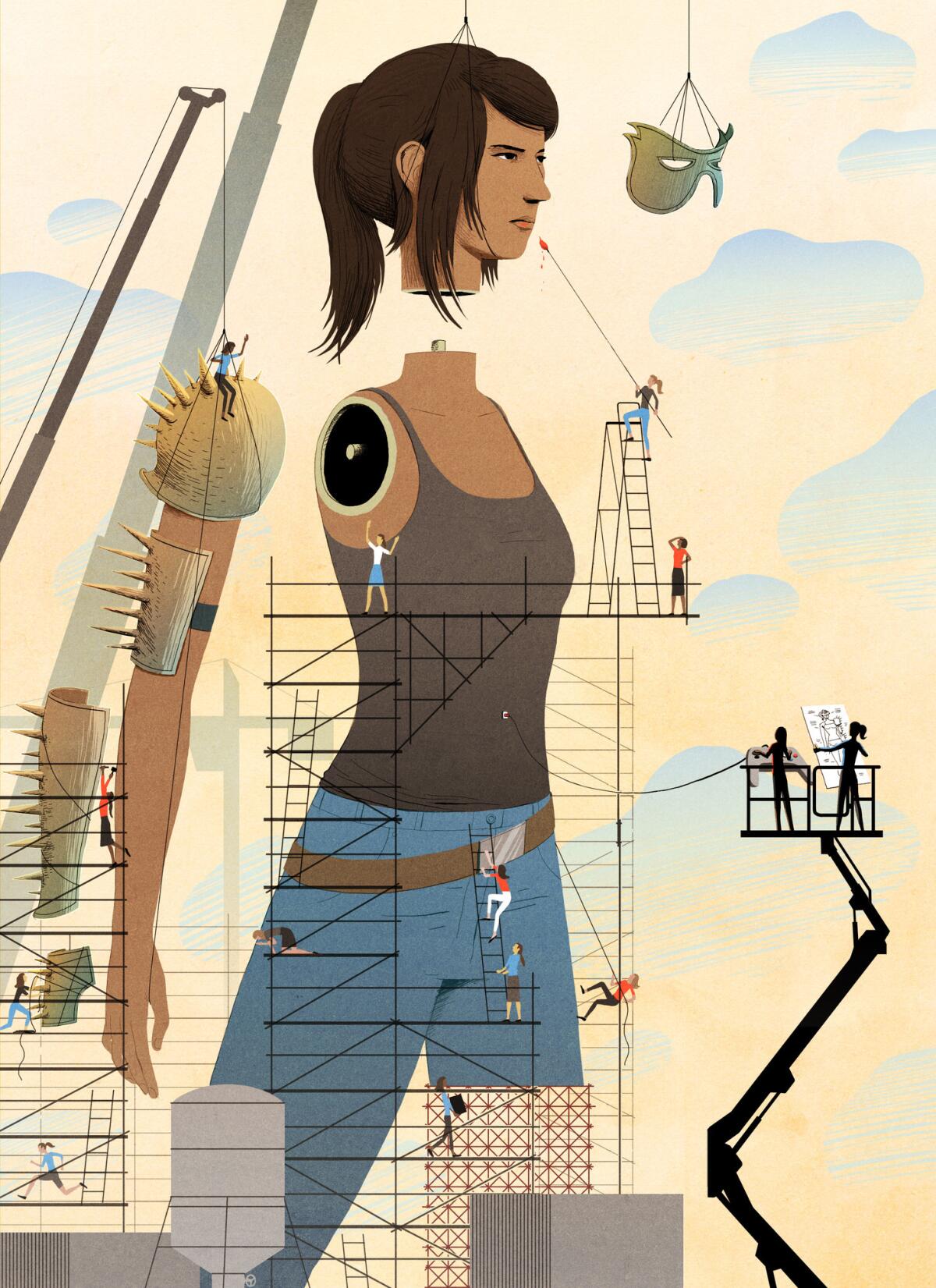
(Michael Kirkham / For The Times)
In video games, an arena of pop-culture that's long been characterized as a boys' club, the news that women now outnumber men in the University of Southern California's graduate video game design program feels revolutionary. And it very well may be.
The women in the USC program, ranked by Princeton Review as the nation's top place to study game design, are enrolled not just because games have changed their lives. They want to change games. "There's not enough stuff that I would want to play," student Stephanie Henderson says.
She's not a fan, for instance, of shooters, the gun-based games that have dominated home video game consoles. There are exceptions — the relatable characters of "The Last of Us" won her over — but she'd prefer to not pull a trigger. "I don't know if I can get into this sniper business," she says. "I want to make more of what I want to play so I can play something that I enjoy." She's far from alone, and the industry appears to be noticing.
FULL COVERAGE: Video game reviews and ruminations
Female characters, while still not the norm, are becoming more prevalent in top-shelf video games. And at USC, there's been a dramatic rise in the acceptance of women into the game design program. In 2011, USC admitted 15 men into its graduate track and five women. In 2015, those numbers were nearly reversed with 12 women and seven men. There's a similar trend at the undergraduate level. In 2012, just seven out of the program's 27 freshmen were women. In 2014, freshmen women outnumbered the men 14 to 7. And in 2015 the numbers were even.
"We live in a culture where the first impulse is to have a male main character, to assume a male gaze on the screen," says Tracy Fullerton, a game designer and professor who oversees the program. "That's got to change. Young women need characters to have as role models. ... It's important. The more that games become a key medium, the more important it becomes for this to happen."
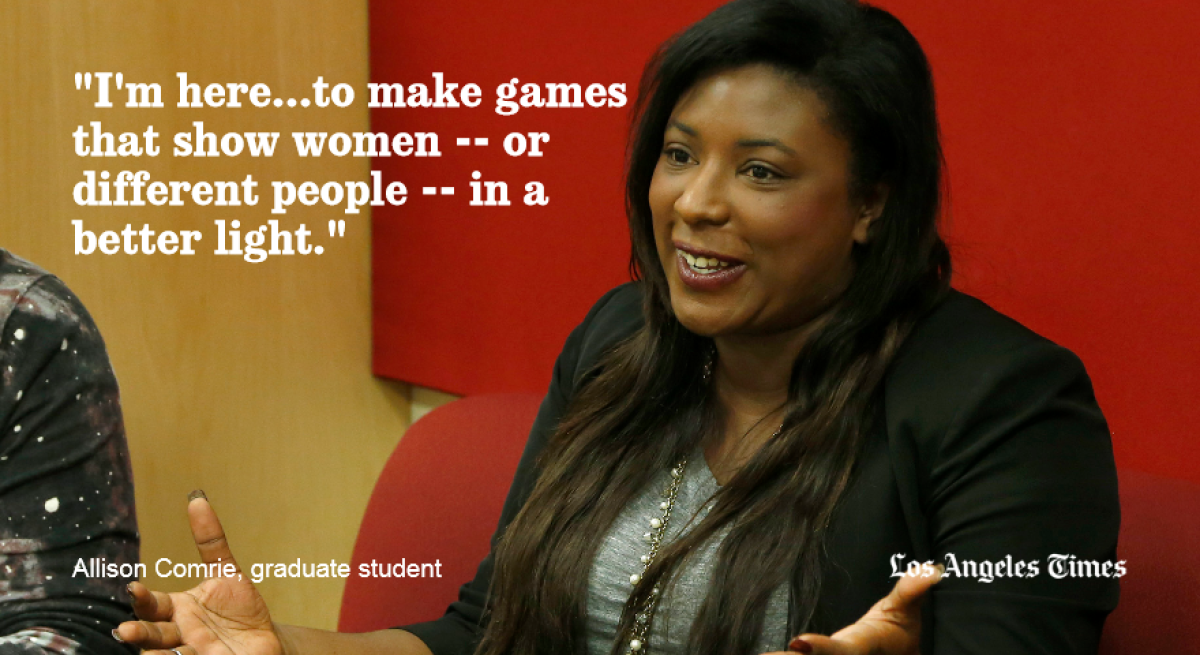
(Kirk McKoy / Los Angeles Times)
Industry observers are optimistic it's already happening.
When queried about the number of women in the industry, Kate Edwards, executive director of the International Game Developers Assn., had a firm answer: "It's going to exponentially increase.
"A lot of that is being fueled by the demographic change in game players, which in the U.S. is about 50/50 male and female," Edwards says. "We're seeing a greater enthusiasm in women and people who have not traditionally been a part of this industry in saying that this is what I love and this is what I want to do."
Granted, when it comes to diversity, there's still a lot of work to be done beyond the collegiate level. Recent IDGA surveys peg the industry as about 80% male. Still, that's a slight improvement from two or three years ago, when women comprised just 12% of the business.
Edwards also points to the content of recent games as a sign of hope that titles are starting to better reflect the multiplicity of their audience. This last year, for example, marked the first time in "Call of Duty" franchise history that fans could play as a woman throughout the entirety of the main storyline.
"Halo 5: Guardians," "Assassin's Creed Syndicate" and "Fallout 4," among others, gave prominent roles to women. And today, Lara Croft has been remade into a believable character, one who just so happens to dress the part of an archaeological adventurer.
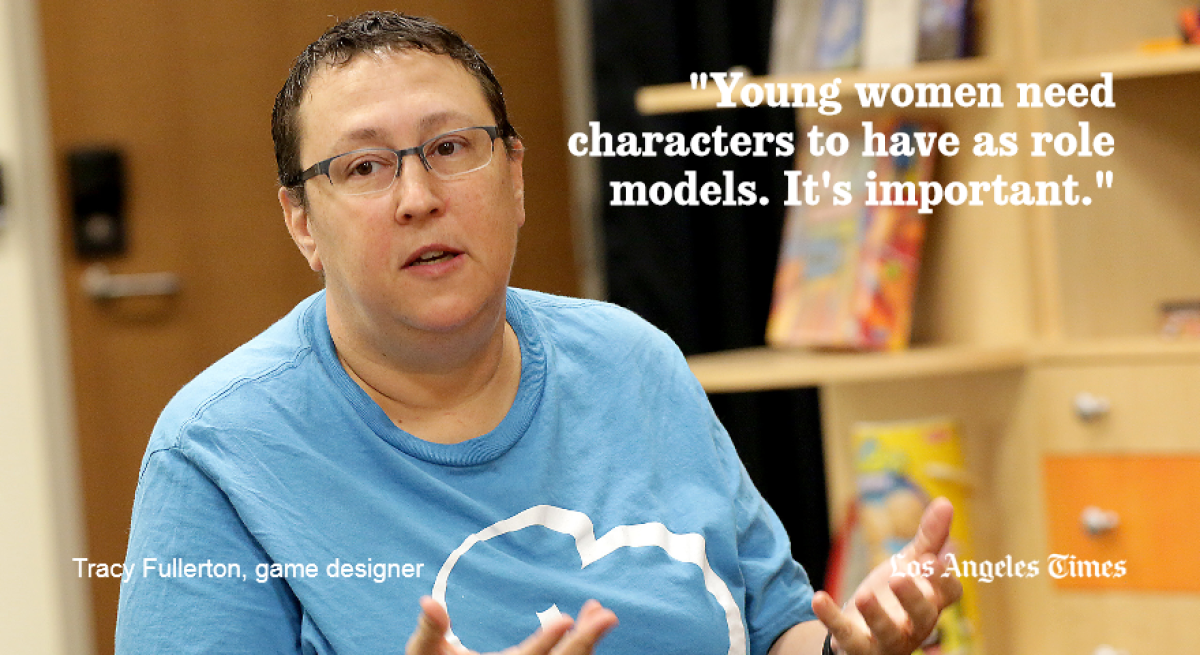
(Kirk McKoy / Los Angeles Times)
That's a change that shouldn't be underestimated, Edwards says.
"They took what was basically the primary example of sexist imagery in the game industry in Lara Croft and now, with the latest two games, they have transformed this iconic sexist character into a great example of how you portray a woman in a game," Edwards says. "Her emotions are real. Her physicality is normal."
Elizabeth Swensen, a research associate at the school and graduate of the program, recalls a far darker time.
"I felt like it was not a game for me," she says of the original late-'90s "Tomb Raider," which she received as a gift when she was child.
That's when the "Tomb Raider" star wore skimpy shorts and a tight top that accentuated her itty-bitty waist and not-so-itty-bitty chest. "I looked at the way these games were advertised," she says. "They generally were advertised for people who were attracted to women," she says of the games. "That was not me. So I felt alienated."
Then Edwards discovered the 2003 game "Beyond Good and Evil," which stars a young photojournalist named Jade who embarks on a conspiracy story involving aliens.
"She's an interesting role model, in that she dressed in a way I could imagine myself dressing," Edwards says. "She fought in a way that I thought was really fun.
"You're just kind of a good, level-headed person who also can be pro-active," she says. "The storyline is pretty basic. Evil government corporation. Good reporter. It's not very nuanced, but for the age I played it, it was just what I was looking for."
There may be more Jade-like characters to come. Female-fronted games such as "Mirror's Edge Catalyst," "ReCore" and "Horizon Zero Dawn" are on the way from major publishers, all of them placing women in video game roles that have traditionally gone to men.
Sitting with the students at USC, it's hard not to see this as the beginning of a new era of diversity.
"I will make a crazy prediction," says Martzi Campos, a master's student in the USC program. "There are the same issues in the film industry, but I would argue that games will grow faster and games will change faster. We're newer. Because film has a long history, it's a bigger boat to steer. Right now, with the indie game explosion, games have the chance to lead the way and be like, 'Hey, films, check us out. Look how diverse and widespread we are.' This is our chance for our medium to really shine."
There will, of course, be obstacles.
For one, the path from student to game designer isn't necessarily a direct and simple one. Then there are the game players themselves.
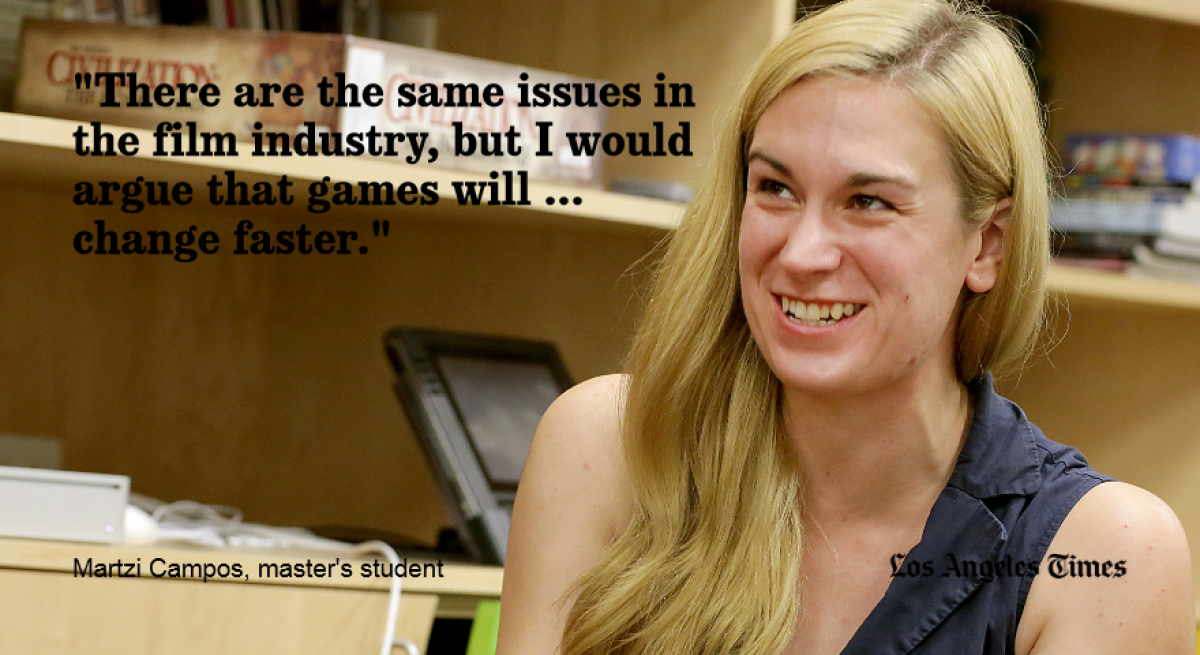
(Kirk McKoy / Los Angeles Times)
In recent years, certain segments of the gaming community haven't always been hospitable when it comes to welcoming new voices, especially those belonging to women.
A 2015 documentary, "GTFO," chronicles the harassment endured by female game developers and critics by members of the game playing community. Outspoken analysts of video games, such as cultural critic Anita Sarkeesian, who created a video series called "Tropes vs. Women in Video Games," are subject to online harassment and death threats.
The industry is aware. "Sexism among gamers" is cited as the No.1 factor when it comes to "influencing society's negative perception of the game industry," according to IDGA's 2015 industry survey.
Then there's "gamergate," the online movement whose followers appear driven by a fear that serious criticism or a rise in diverse, experimental games will result in a sort of politically correct makeover of the medium.
In this climate, it's perhaps something of a miracle that women make up the majority of USC's master's game program. There was a fear, for instance, that gamergate would drive women away from studying games.
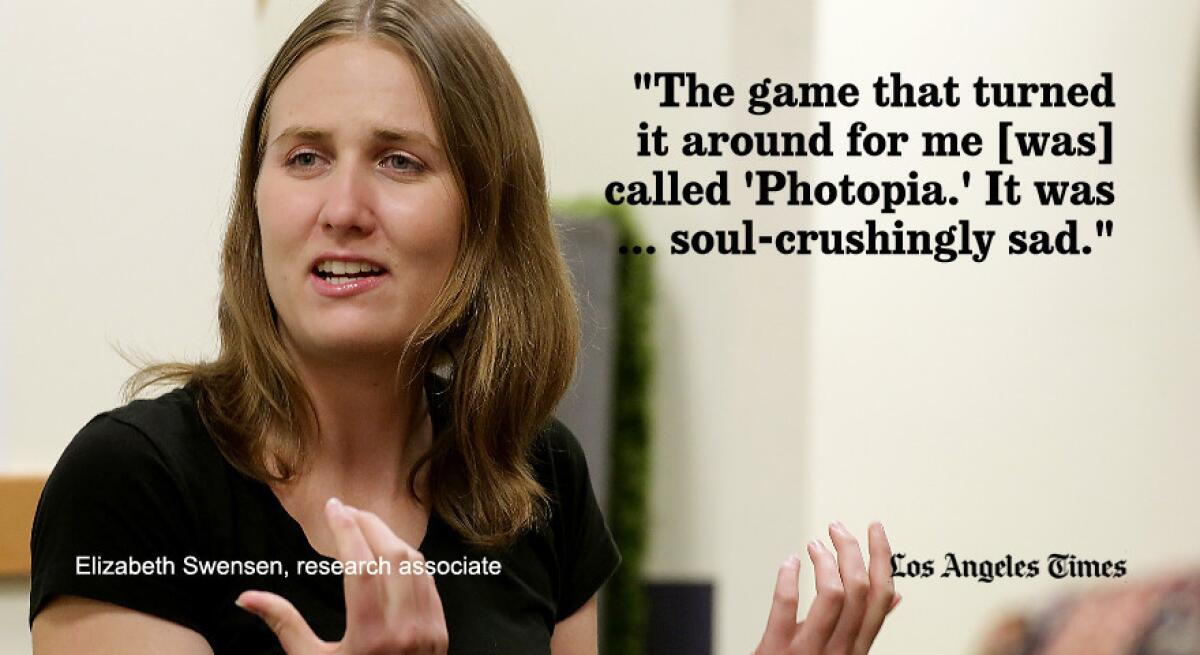
(Kirk McKoy / Los Angeles Times)
"More women and more people of diversity in general are seeing game development as a potential viable career for themselves," Edwards says. "That's despite the very vocal public crap that was going on during gamergate. Even before gamergate, the industry had a reputation as being a boy's club."
That reputation, says graduate student Allison Comrie, comes from the games themselves, whether it was the scantily clad prostitutes of "Grand Theft Auto" or even the damsel-in-distress storylines of many early Nintendo games.
"These are games that don't really place women in good light," Comrie says. "They use women as objects rather than people with agency. Those games give players ideas of what women are.
"That's why I'm here. That's why a lot of us here. We want to make games that show women — or different people — in a better light so it can perpetuate a community that's more unified and diverse."
While everyone at USC speaks highly of the game community, no doubt some have already fought through stereotypes and peculiar looks.
FULL COVERAGE: Video game reviews and ruminations
"When I was 6 or 7, I had a small child-life crisis," says Maria Ferreri, a freshman in the program. "I was starting to like things that were more for guys. I liked electronics and cars and games. I ran to my mom crying and said, 'What's wrong with me? I should have been born a guy.'
"My mom says, 'Maria. It doesn't matter. Be proud of being a woman. Be proud of who you are. You can like and be whatever the hell you want.' I've always held that in the back of my head going forward."
Campos says being a female game devotee set off a few "weirdo alarms" in her day. But, she says, the grief often came from women, not men.
"Like, 'You are deviating from the mean,'" she says.
"That's not to say that girls are terrible," she says. "They just don't realize you have permission to do this."
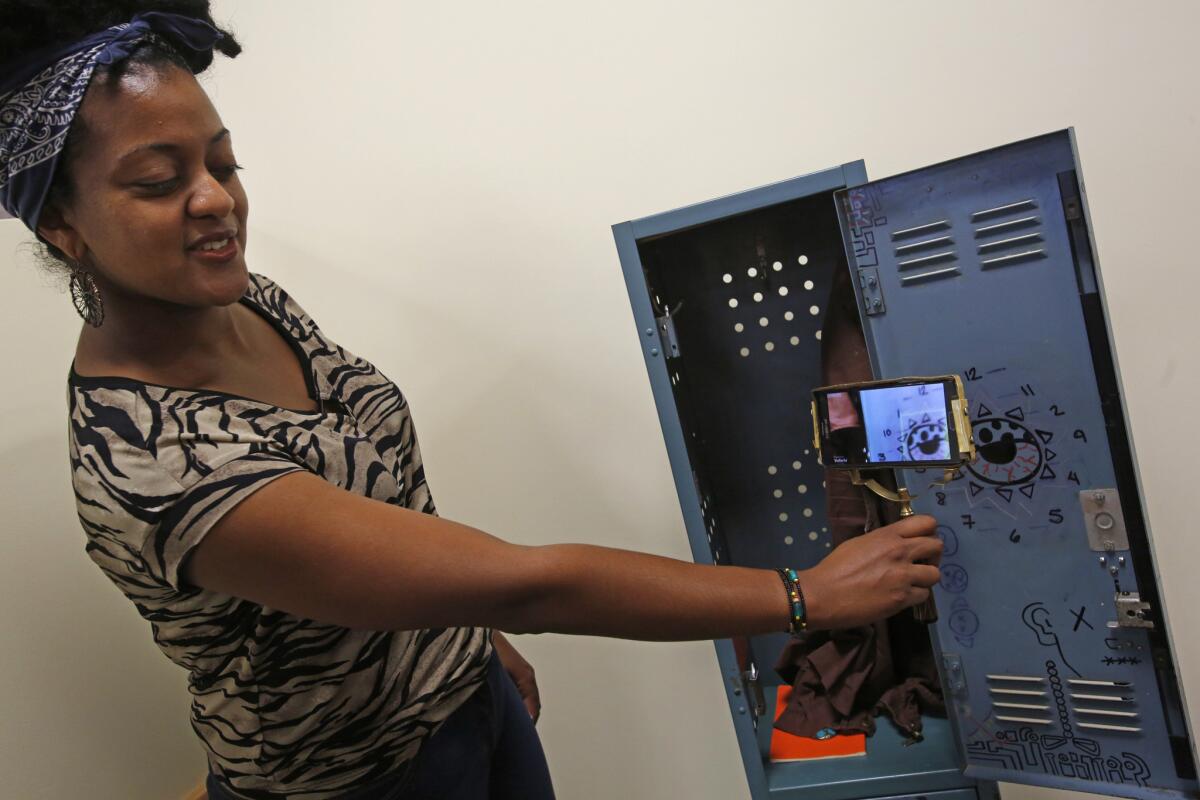
Lishan Amde explains her game titled “The Locker.” To play, the gamer looks for clues to solve a murder -- all in a locker room.
Lishan Amde explains her game titled "The Locker." To play, the gamer looks for clues to solve a murder -- all in a locker room. (Anne Cusack / Los Angeles Times)
The USC Games program has rightfully earned its reputation as a home for thoughtful game experiences. Numerous developers, including Thatgamecompany, Giant Sparrow and the Odd Gentleman, trace their beginnings to the program.
A number of the current students profess a love for more narrative-focused and character-driven titles.
Ferreri is working on a card game involving spies, while Campos has experimented with games that are borderline art installations.
"The game that turned it around for me — the game that gave me the thought, 'maybe there's a job in games for me,'" Swensen says, "was a little single-authored indie text adventure made in 1998 called 'Photopia.' It was very linear, basic puzzle solving, but the narrative format was so intricate, interesting and soul-crushingly sad. That I had never seen a game do. I'm 13 years old, and this game made me cry."
See more of Entertainment’s top stories on Facebook >>
What can still be improved, the students agree during a roundtable discussion, is the way women are portrayed in games. There are some exceptions. Some cite mainstream games such as "The Last of Us" and "Mass Effect" as giving them believable female characters. One says games are still a bit of a "wasteland" when it comes to creating respectable heroines.
In the "Super Mario Bros." universe, for instance, Campos says there's no female character as cool as Mario or Luigi.
"Like," Campos wonders, "where's the Gothed-up princess?"
That's when Fullerton, the head of USC Games, chimes in. "You guys will have to make her."
Follow me on Twitter: @Toddmartens
ALSO:
In facing death, the game 'That Dragon, Cancer' embraces the complexities of life
Why 'Oxenfree' may just be the first must-play game of 2016
In 'Disney Infinity' video game, the 'Star Wars' universe can be upended, if you like
The biggest entertainment stories
Get our big stories about Hollywood, film, television, music, arts, culture and more right in your inbox as soon as they publish.
You may occasionally receive promotional content from the Los Angeles Times.








